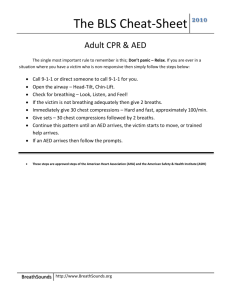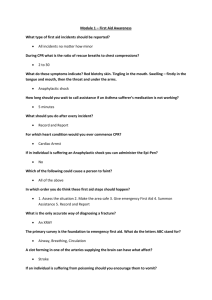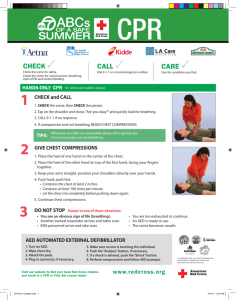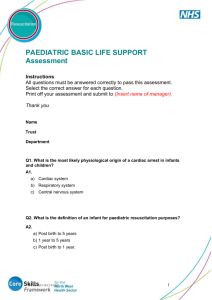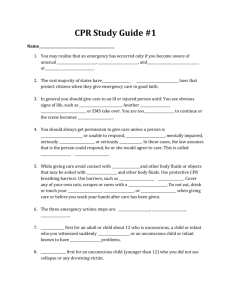Adult CPR/AED Training: First Aid & Emergency Response
advertisement
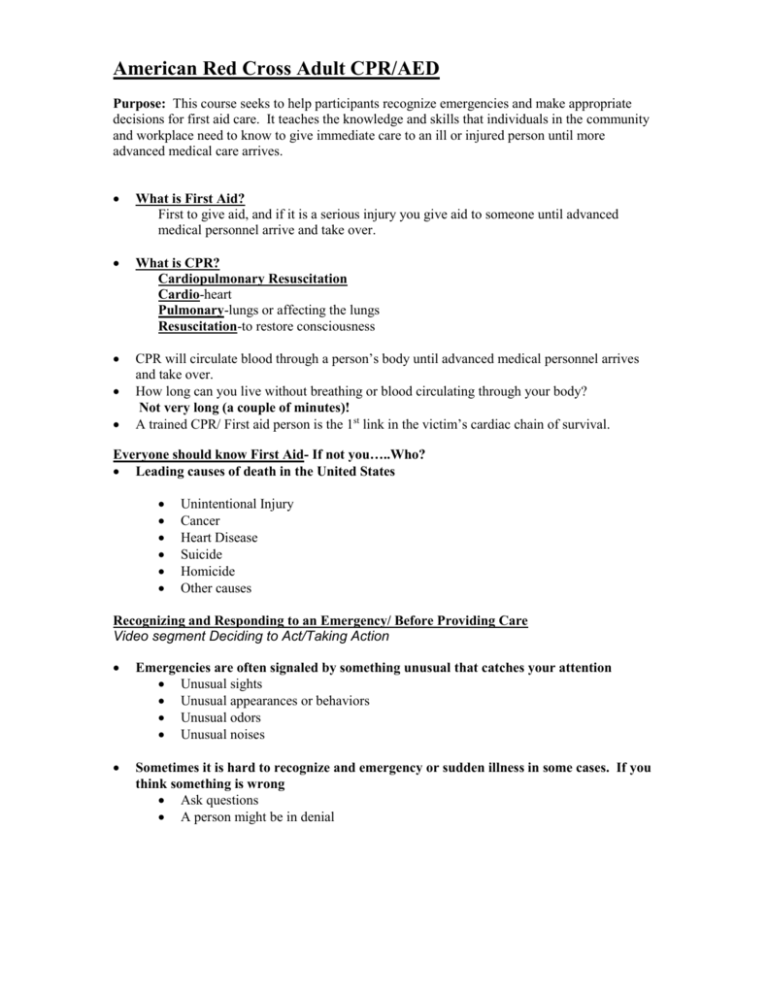
American Red Cross Adult CPR/AED Purpose: This course seeks to help participants recognize emergencies and make appropriate decisions for first aid care. It teaches the knowledge and skills that individuals in the community and workplace need to know to give immediate care to an ill or injured person until more advanced medical care arrives. What is First Aid? First to give aid, and if it is a serious injury you give aid to someone until advanced medical personnel arrive and take over. What is CPR? Cardiopulmonary Resuscitation Cardio-heart Pulmonary-lungs or affecting the lungs Resuscitation-to restore consciousness CPR will circulate blood through a person’s body until advanced medical personnel arrives and take over. How long can you live without breathing or blood circulating through your body? Not very long (a couple of minutes)! A trained CPR/ First aid person is the 1st link in the victim’s cardiac chain of survival. Everyone should know First Aid- If not you…..Who? Leading causes of death in the United States Unintentional Injury Cancer Heart Disease Suicide Homicide Other causes Recognizing and Responding to an Emergency/ Before Providing Care Video segment Deciding to Act/Taking Action Emergencies are often signaled by something unusual that catches your attention Unusual sights Unusual appearances or behaviors Unusual odors Unusual noises Sometimes it is hard to recognize and emergency or sudden illness in some cases. If you think something is wrong Ask questions A person might be in denial Even though people recognize that an emergency has occurred, they fail to act. The most common reasons why people don’t respond are The presence of other people Being unsure of the ill or injured person’s condition The type of injury Fear of catching a disease Fear of doing something wrong Fear of being sued Being unsure of when to call 911 Good Samaritan Laws Give legal protection to people who willingly give emergency care to an ill or injured person without accepting anything in return Obtaining Consent Before giving first aid to a conscious adult, you MUST obtain his/her permission(Consent) to give care A conscious person has the right to refuse or accept care If the person is unconscious or unable to respond consent is Implied, which means if the person could respond, he/she would agree to be cared for Consent is also implied for a child if a parent or guardian is not present or immediately available Preventing Disease Transmission When you follow standard precautions you can reduce your risk of disease transmission Avoid contact with blood or other body fluids Place barriers between you and a person’s blood or other body fluids using such items as Disposable gloves CPR breathing barriers (resuscitation masks, face shields) Wash hands in warm to hot water with soap Emergency Action Steps CHECK – CALL – CARE In any emergency, always follow three emergency action steps. Following these steps can minimize the confusion at an emergency scene. 1. CHECK the scene for safety; then CHECK the ill or injured person CHECK the scene: Is it safe? What happened? How many people are involved? Is there any immediate danger? Is anyone else available to help? CHECK the victim Unconsciousness No breathing or trouble breathing No signs of life (no breathing no movement) Severe bleeding 2. CALL 911 or the local emergency number Calling 911 is the most important action you can take to help an ill or injured person who needs care. It will start emergency medical care on its way as fast as possible. Calling 911 in a cardiac emergency or breathing emergency in which time is critical. Research shows the shorter the time from when a person collapses to when CPR is initiated and when he or she is given the first shock with an automated external defibrillator (AED), the greater the chance of survival. 3. CARE for the ill or injured person Give the appropriate care to the victim If alone give 2 minutes of CARE then call 911 Moving an ill or injured person One of the most dangerous threats to a seriously injured person is unnecessary movement. Calling 911 is the most important step you can take in an emergency to help the person in need of care Moving a seriously injured person can cause additional injury and pain and complicate the person’s recovery Therefore, you should move a person ONLY under the following situations When you are faced with immediate danger When you have to get to another person who may have a more serious injury or illness When you need to provide proper care When the scene becomes unsafe Checking a Conscious Person Video segment- Checking a Conscious- Adult CHECK the scene for safety, CHECK the person for life-threatening conditions Tell the person not to move and get consent to give care CALL 911 CARE for the victim If there are no life-threatening conditions ask these questions What is your name? What happened Where do you feel pain or discomfort? Do you feel and numbness? Do you have allergies? Do you have any medical conditions or are you taking any medications? When did you last eat or drink? Shock Shock is a life-threatening condition in which not enough blood is being delivered to all parts of the body and body systems, and organs begin to fail. Signals of Shock Restlessness or irritability Altered level of consciousness Nausea or vomiting Rapid breathing and pulse Pale or ashen, cool, moist skin Excessive thirst Care for Shock Call 911 Monitor ABC’s (Airway, Breathing, Circulation) Control External Breathing Elevate legs 12 inches Do not give the person anything to eat or drink- they victim may be thirsty but if surgery is required it is better if the stomach is empty. Checking an Unconscious Person Video Segment Checking an Unconscious Adult How to give rescue Breaths-Adult CHECK the scene for safety, CHECK the victim for life-threatening conditions Tap shoulder and shout, “Are you Okay?” If no response call 911 CALL 911 CARE for the victim (If an unconscious person is face-down, roll face-up supporting the head, neck and back. Open Airway- Check ABC’s (signs of life) for no more than 10 seconds Airway- Open the airway Breathing- Check for movement or breathing Circulation- Check for signs of life (pulse) and severe bleeding If no breathing, give 2 rescue breaths (give breaths over a period of about 1 second in-between) Breathing Emergencies Video Segment Signals of a Heart Attack and the Cardiac Chain of Survival A breathing emergency occurs when a person is having trouble breathing (respiratory distress) or cannot breathe at all (respiratory arrest). Breathing emergencies are life threatening 0 minutes-Breathing stops. Heart will stop beating soon 4-6 minutes- Brain damage possible 6-10 minutes- Brain damage likely Over 10 minutes- Irreversible brain damage certain Causes of Breathing Emergencies A partially obstructed airway Illness Chronic condition, such as asthma Electrocution Heart Attack Injury to the head, chest, lungs or abdomen Allergic reaction Drugs Poisoning Emotional distress Signals of Breathing Emergencies The person is having trouble breathing Breathing is slow or rapid Breaths are unusually deep or shallow The person is gasping for breath The person is wheezing, gurgling or making high-pitched noises In an unconscious person, you may detect irregular, gasping or shallow breaths. The person’s skin is unusually moist or cool and has a flushed, pale, ashenor bluish appearance The person feels Short of breath Dizzy or light-headed Pain in the chest or tingling in the hands, feet or lips Apprehensive or fearful Conscious Choking Video Segment Conscious Choking-Adult Common injury that can lead to death If a person is conscious and cannot cough, speak or breathe, assume that the airway is blocked A person who is choking may clutch at his or her throat. This gesture is the universal sign of choking If person is coughing it means the airway is only partially blocked – Encourage the person to keep coughing Check- scene for safety Check- person- Ask Person “Are you choking?” Call – 911 Care –for the victim Lean person forward and give 5 back blows with the heel of your hand Give 5 quick, upward abdominal thrusts Continue back blows and abdominal thrusts until Object if forced out Person can breathe or cough forcefully Person becomes unconscious Give chest thrusts to a choking person who is pregnant or too big for your to reach around You can give yourself abdominal thrusts by using your hands, just as you would do to another person, or lean over and press your abdomen against and firm object such as the back of a chair CPR- Adult Video Segment CPR-Adult An adult in cardiac arrest is unconscious and shows no other signs of life (movement or breathing). Loss of these signs of life can indicate cardiac arrest. CPR is a combination of chest compressions and rescue breaths that can help circulate blood containing oxygen to vital organs (cardio-pulmonary resuscitation) CHECK the scene for safety, CHECK the victim for life-threatening conditions Tap shoulder and shout, “Are you Okay?” If no response call 911 CALL 911 (or have someone else call 911) If alone give 2 minutes of care then call 911 CARE for the victim (If an unconscious person is face-down, roll face-up supporting the head, neck and back. Open Airway- Check ABC’s (signs of life) for no more than 10 seconds Airway- Open the airway Breathing- Check for movement or breathing Circulation- Check for signs of life (pulse) and severe bleeding If no breathing, give 2 rescue breaths(give breaths over a period of about 1 second in-between) If breaths go in and there is no pulse and no breathing go in to CPR Give 30 chest compressions 2 rescue breaths Hand position is 2 hands in center of chest (on lower half of the sternum) Compress chest 1 ½ to 2 inches Breathe into victim make sure chest rises (about 1 second per breath) 30 compressions 2 breaths Rate is about 30 compressions in about 18 seconds (100 compressions per minute) Should be able to complete 5 cycles of compressions and breaths in 2 minutes CPR once started should not be interrupted or stopped until an AED is ready to use, another trained responder takes over or you see an obvious sign of life. Once CPR has been started continue until you are too exhausted to continue CPR is and important link in the Cardiac Chain of Survival because it helps circulate blood that contains oxygen to the vital organs until an AED is ready to use or advanced medical personnel arrive. Unconscious Choking Video Segment- Unconscious Choking-Adult If you attempt rescue breaths but are unable to make the person’s chest clearly rise, you must act quickly to get air into the person. The care for an unconscious choking person is very similar to the skill of CPR, with exception that you look for (and remove) a foreign object between compressions and breaths. Chest compressions are used to help force air from the person’s lungs to dislodge the object. CHECK the scene for safety, CHECK the victim for life-threatening conditions Tap shoulder and shout, “Are you Okay?” If no response call 911 CALL 911 (or have someone else call 911) If alone give 2 minutes of care then call 911 CARE for the victim (If an unconscious person is face-down, roll face-up supporting the head, neck and back. Open Airway- Check ABC’s (signs of life) for no more than 10 seconds Airway- Open the airway Breathing- Check for movement or breathing Circulation- Check for signs of life (pulse) and severe bleeding If no breathing, give 2 rescue breaths(give breaths over a period of about 1 second in-between) If breaths do not go in (chest does not rise) Tilt head farther back Try 2 rescue breaths again If chest does not rise Give 30 chest compressions Look for object(remove object if one is seen) 2 rescue breaths If breaths finally go in check for signs of life AED- ADULT Video Segment –Using an AED -Adult CPR begun immediately and continued until defibrillation is available helps to circulate blood that contains oxygen to the brain and other vital organs. CPR is performed in conjunction with the use of an automated external defibrillator (AED). An AED is a device that analyzes the heart’s electrical rhythm and, if necessary, prompts you to deliver a shock to a person experiencing sudden cardiac arrest. Defibrillation is a process of delivering an electrical shock that disrupts a heart’s electrical activity long enough to allow the heart to spontaneously develop and effective rhythm on its own. If the AED prompts you “No shock advised,” the AED will prompt you to continue CPR. Each minute that defibrillation is delayed reduces the chance of survival of a sudden cardiac arrest victim by about 10 percent. Early defibrillation can save the lives of more people in cardiac arrest. Using an AED on an Adult CHECK the scene for safety, CHECK the victim for life-threatening conditions Tap shoulder and shout, “Are you Okay?” If no response call 911 CALL 911 (or have someone else call 911) CARE for the victim (If an unconscious person is face-down, roll face-up supporting the head, neck and back.) Open Airway- Check ABC’s (signs of life) for no more than 10 seconds Airway- Open the airway Breathing- Check for movement or breathing Circulation- Check for signs of life (pulse) and severe bleeding If no signs of life Turn on the AED Wipe Chest dry (remove any medication patches with a gloved hand) Attach one pad to upper right chest (chest must be bare) Attach one pad to lower left side (must be bare) Make sure no one, including you is touching the person Say “Everyone Stand Clear Push ANALYZE button- let AED analyze heart rhythm If shock advised Say “Everyone Stand Clear Push shock button when prompted After shock is given or “No shock advised” Give 5 cycles or about 2 minutes of CPR Continue with AED and CPR until advanced medical personnel arrive and take over.
